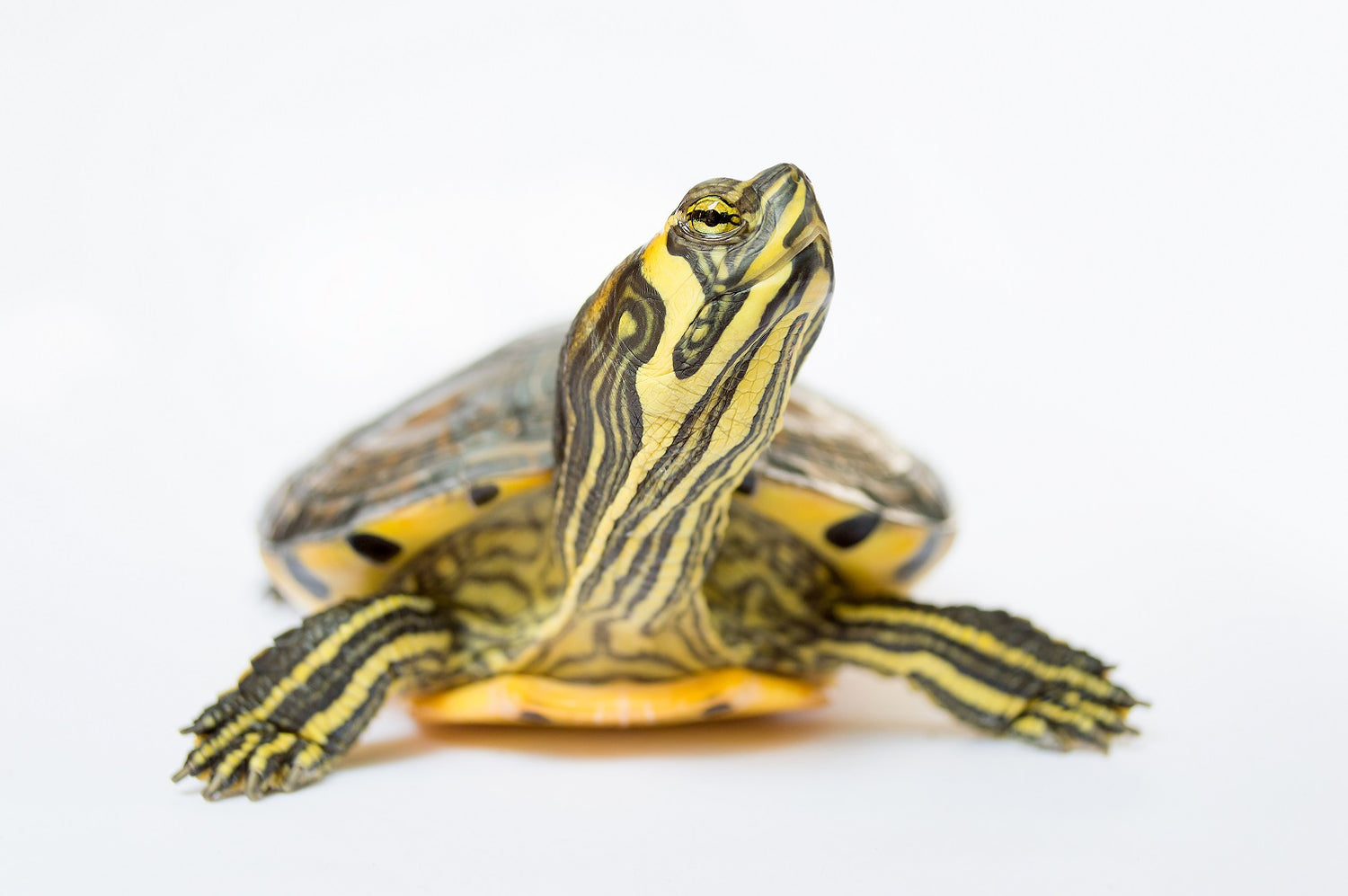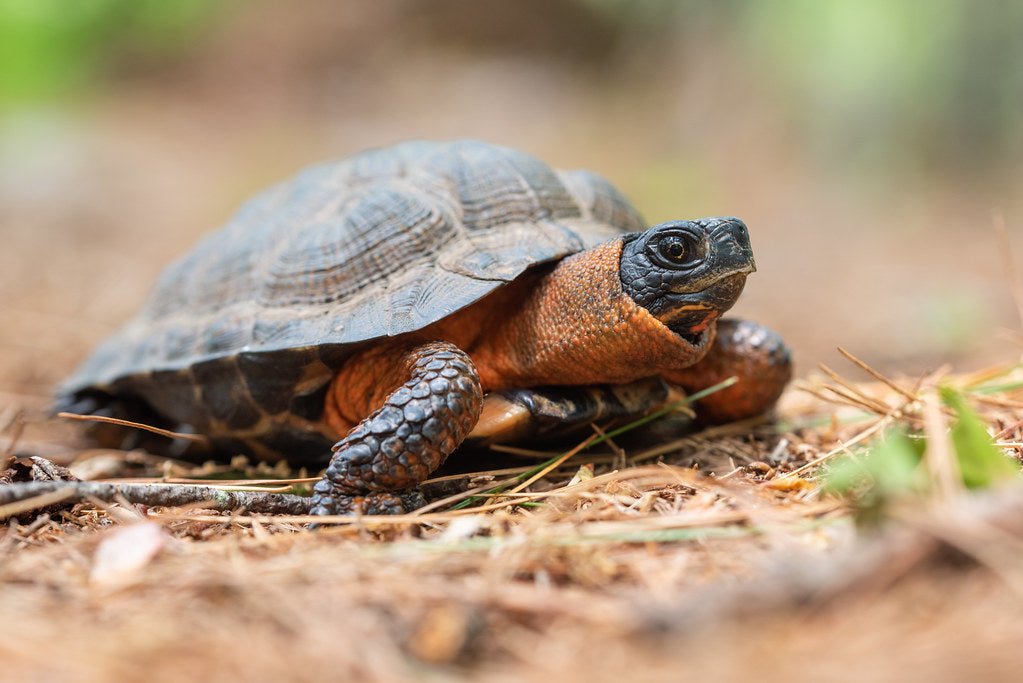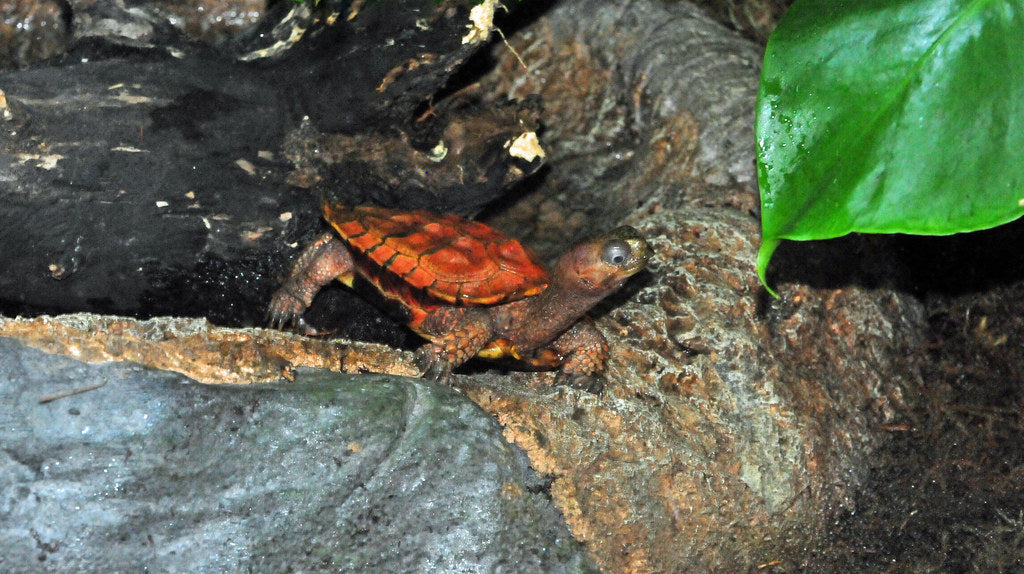Yellow-bellied sliders (Trachemys scripta scripta) are large, semi-aquatic, diurnal reptiles native to the southern United States. They can be found in ponds, lakes, swamps, and slow-flowing rivers, spending most of their lives in the water.
Yellow-bellied sliders generally grow up to 8-11” long, with a smooth oval shell, webbed feet, elongated head, nostrils at the tip of the snout, and eyes close to the nose. The skin and shell are striped green and yellow, with a prominent yellow band behind each eye. The plastron is yellow, typically with two dark spots on the chest.
Yellow-bellied sliders are popular pets, but they take up a lot of space and have very specific needs which require specific equipment to meet. This can make their enclosure inconvenient and expensive to set up. But when you’ve dedicated yourself to caring for this pet properly, they can live up to 30 years.
Note: Yellow-bellied sliders may be very common in the US, but that is not a reason to take one from the wild! If you want a pet yellow-bellied slider, purchase one from a breeder or adopt one from a rescue or your local classifieds.
How much space do yellow-bellied sliders need?
Yellow-bellied sliders are amphibious and fairly active, so they need an enclosure that will appropriately accommodate their preferred lifestyle. The enclosure should be large enough to provide at least 10 gallons of water per inch of the turtle’s expected adult length, which means you will need at least 110 gallons of water. Although an aquarium can be adapted for the purpose, a Waterland tub is the best style of enclosure for this species.
Yellow-bellied sliders tend to do best when housed outdoors where local climate permits, even if it’s just during part of the year. Depending on the subspecies, where you live, and how you’ve set up your pond, it may even be safe for them to hibernate through the winter. Outdoor housing is a convenient way to provide your turtle with plenty of space and “free” heating and lighting, but make sure the enclosure is well secured against both escape and potential predators.
It is best practice not to house multiple yellow-bellied sliders in the same enclosure unless you have a large pond.
Do yellow-bellied sliders need UVB?
Yellow-bellied sliders require regular exposure to high-quality UVB in order to maintain optimal health and wellbeing. Providing UVB lighting to your turtle gives them all of the vitamin D that their body needs, stimulates better appetite and activity, and strengthens the immune system, as well as other benefits.
The best UVB bulbs for yellow-bellied sliders are:
- Zoo Med Reptisun T5 HO 5.0
- Arcadia Forest 6%
The UVB bulb should be half the length of the enclosure and housed in a reflective fixture like the Arcadia ProT5 or Vivarium Electronics. Place the lamp close to the heat lamps, about 13-14” above the basking platform if there’s no mesh obstruction, but 8-11” away if there is mesh. UVB bulbs decay over time, so don’t forget to replace your bulb every 12 months to maintain good performance.
It’s also a good idea to provide a strong LED or T5 HO 6500K daylight lamp for additional illumination. This helps better replicate daylight and is also good for any live plants you may be using.
Lights should be on for 14 hours/day during summer and 10 hours/day during winter. If you are housing your turtle outdoors in an appropriate climate, supplementary lighting is not required.
What basking temperatures do yellow-bellied sliders need?
Yellow-bellied sliders are ectotherms, which means that they rely on the variable temperatures of their environment to help regulate their metabolism and stay healthy. Here’s the range of temperatures a yellow-bellied slider’s indoor enclosure should offer:
- Basking (surface temp): 104°F
- Basking (air temp): 85-90°F
- Water (juveniles): 78-82°F
- Water (subadults/adults): 70-88°F
Measure basking temperature with a digital probe thermometer, and water temperature with a high-quality aquarium thermometer.
A good way to warm the basking area is with a couple of halogen flood heat lamps clustered on one side of the enclosure and positioned over a sturdy basking branch or rock. Do not use ceramic heat emitters (CHEs), red bulbs, or blue bulbs, as these are not as effective. Increase the wattage if they’re too cool, and use a plug-in lamp dimmer if they’re too warm.
If you need to heat the water, use a high-quality aquarium heater rated for at least the maximum volume of water in the enclosure.
If you are housing your turtle outdoors, supplementary heating should not be required. However, they may need to be brought indoors for the winter once temperatures in your area get below 50°F.
What water conditions do yellow-bellied sliders need?
Yellow-bellied sliders are semi-aquatic, which means that most of the enclosure should be water. This water must be kept clean at all times in order to keep your turtle healthy (and to keep the aquarium attractive). The most efficient way to do this is with a combination of excellent filtration and regular water changes.
Aquatic turtles are fairly messy creatures, so you will need a canister-style filter capable of handling at least 2-3x the amount of water in the enclosure. So, if you have an aquarium or pond with 110 gallons of water, you will need a canister filter rated for at least 220 gallons of water. Don’t settle for the cheapest filter you can find — this is one aspect of your turtle’s enclosure not to skimp on!
Once every 1-2 weeks, remove and replace approximately 30% of the aquarium/pond’s total water volume. This helps minimize buildup of toxic compounds in the water that a filter is unable to resolve. To make the job easier, use a siphon or water pump.
Both indoor and outdoor turtle ponds require filtration and water changes.
Conditioning the water to remove chlorine and chloramines with a reptile-safe product such as Zoo Med ReptiSafe may be beneficial.
What substrate is good for yellow-bellied sliders?
If you are using a Waterland tub or similar setup, the land portion of the enclosure should offer several inches of moist, sandy soil. You can do this with Zoo Med Reptisoil or by mixing your own substrate with approximately 80% clean topsoil and 20% play sand (measured by volume).
Substrate is not required in the aquatic portion of the enclosure, although it does offer a form of enrichment when provided, encouraging natural behaviors. Sand and crushed coral are the best options. This must be cleaned with a siphon regularly, preferably at each water change. Avoid pebbles or gravel.
What décor can you use in a yellow-bellied slider terrarium?
The most essential piece of “decor” you will need in your turtle’s enclosure is going to be a basking platform. Ideally, this should be a partitioned-off area of land where the turtle can climb out of the water, bask, explore, and burrow (as discussed above). If that is not possible, securely stacked rocks, a large piece of wood, or a commercially-available turtle basking platform can be used as a basking location. The turtle should be able to easily climb onto the platform, and it must be large enough for the turtle to remove its entire body from the water and walk around a bit.
Aside from the basking area, there are additional ways you can increase the enclosure’s functionality and general attractiveness. Here are some ideas:
- live/artificial plants
- mopani wood
- hollow logs
Make sure your turtle has access to places where it can hide from view as needed. Hollow underwater hiding areas should be large enough that the turtle can’t get stuck, as this can lead to drowning!
What do yellow-bellied sliders eat?
Yellow-bellied sliders are omnivores, which means that they need to eat a balanced diet of both plant- and animal-based foods to get the nutrition that they need. Here is a general feeding schedule to follow:
Yellow-bellied sliders younger than 6 months:
- 50% protein / 50% vegetables
- protein food or pellets daily
- vegetable food daily
Yellow-bellied sliders between 6-12 months:
- 50% protein / 50% vegetables
- protein food or pellets every other day
- vegetable food daily
Yellow-bellied sliders older than 1 year:
- 25% protein / 75% vegetables
- protein food or pellets 2-3x/week
- vegetable food daily
A portion of chopped/shredded vegetables should be roughly the same size as the turtle’s shell. A portion of pellets or protein food should be roughly the same size as the turtle’s head.
Animal-based foods for yellow-bellied sliders: crickets, earthworms, dubias, freeze-dried shrimp/krill, frozen bloodworms, blackworms, silkworms, snails, guppies, mollies, platies, mosquito fish, crayfish
Vegetable foods for yellow-bellied sliders: collard greens, dandelion greens + flowers, endive, green leaf lettuce, kale, red leaf lettuce, romaine lettuce, duckweed, filamentous algae, water hyacinth, water lettuce
Pellets for yellow-bellied sliders: Omega One Juvenile Turtle Pellets, Omega One Adult Turtle Sticks, Tetra ReptoMin, Zoo Med Natural Aquatic Turtle Food, Mazuri Aquatic Turtle Diet
For extra calcium, your turtle should have access to a cuttlebone or calcium block at all times.
Do yellow-bellied sliders like to be handled?
As a general rule, turtles do not like to be handled. Keep handling to a minimum unless it is absolutely necessary for inspection or transportation (ex: going to the vet for a checkup). If you would like to interact with your turtle, try hand-feeding it with a pair of feeding tongs.
*This care sheet contains only very basic information. Although it’s a good introduction, please do further research with high-quality sources to obtain additional information on caring for this species.




Leave a comment
This site is protected by hCaptcha and the hCaptcha Privacy Policy and Terms of Service apply.